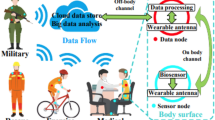The wide use of small-sized wearable electronic devices in various practical human activities makes it relevant to measure the proportion of electromagnetic energy absorbed by the human body. One of the most important parameters that determines it is the specific absorption rate. In this article the authors propose a method for determining this coefficient for a liquid phantom with the use of computer simulation and experimental measurement of the microstrip patch antenna parameters. The antenna is located on an elliptical cylinder and operates in the wireless medical body area network. The method is based on measuring the rise in temperature of the liquid phantom exposed to electromagnetic waves generated by a microstrip patch antenna over a certain time. Homogeneous liquid phantom was created by changing the percentage of salt and sugar in 250 g of water, the skin phantom — by changing the percentage of water in 200 g of glycerol. The proposed specific absorption rate measurement method eliminates the need to purchase an expensive set of dielectric probes, which demonstrates its cost-effectiveness. The results of experimental measurements are in good agreement with the results of the performed computer simulation.



Similar content being viewed by others
Notes
GOST R IEC 62209-1-2008. Human Exposure to Radio Frequency Fields from Hand-Held and Body-Mounted Wireless Communication Devices. Human Models, Measuring Instruments and Procedures.
Thermographic Method. SPEAG. DAK – Dielectric Assessment Kit Product Line, http://www.speag.com/products/dak/.
References
V. Kumar and B. Gupta, Design Aspects of Body-Worn UWB Antenna for Body-Centric Communication: A review, Wirel. Pers. Commun., 97, 5865–5895 (2017).
V. O. Samoilov, V. G. Vladimirov, and L. A. Sharova, Radiobiology of Non-Ionizing and Ionizing Radiation: Textbook, Izdatel'stvo Politekhnicheskogo Universiteta, St. Petersburg (2011).
Yu. B. Kudryashov, Yu. F. Perov, and A. B. Rubin, Radiation Biophysics: Radio Frequency and Microwave Electromagnetic Radiation: Textbook for Universities, Fizmatlit, Moscow (2008).
D. Rano and M. Hashmi, Extremely Compact EBG‐Backed Antenna for Smartwatch Applications in Medical Body Area Network, IET Microw. Antenna P., 13, No. 7, 1031–1040 (2019).
D. Rano and M. Hashmi, Design and Analysis of Wearable Patch Antenna Array for MBAN Applications, 2016 Twenty Sec. National Conf. on Communication (NCC), pp. 1–6 (2016).
S. V. Yargin, On the Biological Effect of Electromagnetic Radiation in the Radio Frequency Range, Sibirsk. Nauch. Medits. Zh., 39, No. 5, 52–61 (2019).
S. V. Yargin, On the Issue of Biological Effects of Electromagnetic Radiation in the Radio Frequency Range, Tekh. Tekhnol. Inzh., 5, No. 3, 14–19 (2017).
Y. Gao, M. T. Ghasr, M. Nacy, and R. Zoughi, Towards Accurate and Wideband in Vivo Measurement of Skin Dielectric Properties, IEEE Trans. Instrum. Meas., 68, No. 2, 512–524 (2019).
Ł. Januszkiewicz and S. Hausman, Simplified Human Phantoms for Wireless Body Area Network Modelling, 2015 9th European Conf. on Antennas and Propagation (EuCAP), pp. 1–4 (2015).
K. Kiminami, T. Iyama, T. Onishi, and S. Uebayashi, Novel Specific Absorption Rate (SAR) Estimation Method Based on 2-D Scanned Electric Fields, IEEE Trans. Electromagn. C., 50, No. 4, 828–836 (2008).
Y. Okano, T. Sato, and Y. Sugama, A Specific Absorption Rate Measurement Method Using Fiber Optic Thermal Sensors, IEEE Trans. Instrum. Meas., 59, No. 6, 1705–1714 (2010).
Y. Okano and H. Shimoji, Comparison Measurement for Specific Absorption Rate with Physically Different Procedure, IEEE Trans. Instrum. Meas., 61, No. 2, 439–446 (2012).
Y. Okano, K. Ito, I. Ida, and M. Takahashi, The SAR Evaluation Method by a Combination of Thermographic Experiments and Biological Tissue-Equivalent Phantoms, IEEE Trans. Microw. Theory, 48, No. 11, 2094–2103 (2000).
Author information
Authors and Affiliations
Corresponding author
Additional information
Translated from Izmeritel'naya Tekhnika, No. 1, pp. 44–48, January, 2023.
Rights and permissions
Springer Nature or its licensor (e.g. a society or other partner) holds exclusive rights to this article under a publishing agreement with the author(s) or other rightsholder(s); author self-archiving of the accepted manuscript version of this article is solely governed by the terms of such publishing agreement and applicable law.
About this article
Cite this article
Rano, D., Yelizarov, A.A., Nazarov, I.V. et al. Differential Method for Determining the Specific Absorption Rate of Electromagnetic Energy of a Liquid Phantom. Meas Tech 66, 45–50 (2023). https://doi.org/10.1007/s11018-023-02188-8
Received:
Accepted:
Published:
Issue Date:
DOI: https://doi.org/10.1007/s11018-023-02188-8




